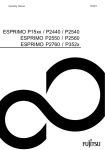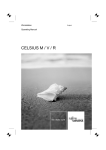Download Fujitsu CELSIUS W370
Transcript
CELSIUS W370
Operating Manual
Are there ...
... any technical problems or other questions that you would like help with?
Please contact:
●
our Hotline/Help Desk
(see the enclosed Help Desk List or look us up on the Internet:
http://ts.fujitsu.com/support/helpdesk.html)
●
your sales partner
●
Your sales office
Further information can be found in the "Safety" and "Warranty" manuals.
The latest information on our products, tips, updates, etc., can be found on the Internet at:
http://ts.fujitsu.com
Published by
Fujitsu Technology Solutions GmbH
A26361-K1000-Z221-1-7619, Edition 2
2009/08
Produced by
XEROX Global Services
Introduction
Important notes
CELSIUS W370
Preparing for use
Operation
Troubleshooting and tips
Operating Manual
System upgrades
Technical data
Index
August 2009 edition
CELSIUS is a registered trademark of Fujitsu Technology Solutions GmbH.
Windows XP, Windows Vista and Windows 7 are registered trademarks of Microsoft
Corporation.
PS/2 is a registered trademark of International Business Machines, Inc.
Pentium is a registered trademark of Intel Corporation, USA.
Kensington and MicroSaver are registered trademarks of ACCO World Corporation.
Acrobat Reader is a trademark of Adobe Systems Incorporated.
All other trademarks referenced are trademarks or registered trademarks of their respective
owners, whose protected rights are acknowledged.
Copyright © Fujitsu Technology Solutions GmbH 2009
All rights, including rights of translation, reproduction by printing, copying or similar methods,
in part or in whole, are reserved.
Offenders will be liable for damages.
All rights reserved, particularly for rights created by patent grant or registration of a utility
model or design.
Delivery subject to availability. Right of technical modification reserved.
Contents
Your CELSIUS … ................................................................................................................................ 1
Notational conventions ......................................................................................................................... 2
Important notes .................................................................................................................................. 3
Safety notes.......................................................................................................................................... 3
Transporting the device ........................................................................................................................ 3
Cleaning the device .............................................................................................................................. 3
Energy saving, disposal and recycling ................................................................................................. 4
CE marking........................................................................................................................................... 4
FCC Class B Compliance Statement ................................................................................................... 4
Preparing for use................................................................................................................................ 5
Unpacking and checking the delivery ................................................................................................... 5
Steps for initial setup ............................................................................................................................ 5
Setting up the device ............................................................................................................................ 6
External devices, connecting................................................................................................................ 6
Ports ............................................................................................................................................. 7
Connecting the monitor ................................................................................................................ 8
Connecting the mouse ................................................................................................................. 9
Connecting the keyboard.............................................................................................................. 9
Connecting external devices to the parallel or serial port........................................................... 10
Connecting external devices to the USB ports........................................................................... 10
Connecting the device to the mains voltage....................................................................................... 11
Switching on for the first time: installing the software......................................................................... 12
Switching on monitor and device................................................................................................ 13
Installing the software................................................................................................................. 14
Operation........................................................................................................................................... 15
Switch the device on........................................................................................................................... 15
Switching off the device...................................................................................................................... 15
Indicators provided by the device ....................................................................................................... 16
Keyboard ............................................................................................................................................ 17
Important keys and key combinations ........................................................................................ 17
Settings in BIOS Setup....................................................................................................................... 19
Property and data protection .............................................................................................................. 19
Mechanical casing lock (optional) .............................................................................................. 19
Anti-theft protection and lead-sealing......................................................................................... 20
BIOS setup security functions .................................................................................................... 20
Access authorization via SmartCard .......................................................................................... 21
Access protection with SystemLock ........................................................................................... 21
Troubleshooting and tips................................................................................................................. 23
Help if problems occur........................................................................................................................ 23
Troubleshooting.................................................................................................................................. 24
The device cannot be switched off with the ON/OFF switch. ..................................................... 24
Monitor remains blank ................................................................................................................ 25
No mouse pointer displayed on the screen ................................................................................ 27
The floppy disk cannot be read or written................................................................................... 27
Time and/or date is not correct................................................................................................... 28
Error messages on the screen ................................................................................................... 28
Installing new software ....................................................................................................................... 28
Hard disk contents, restoring.............................................................................................................. 28
Tips 29
A26361-K1000-Z221-1-7619, edition 2
Contents
System upgrades ..............................................................................................................................31
Information about boards ....................................................................................................................31
Opening the casing .............................................................................................................................32
Closing the casing...............................................................................................................................33
Installing the locking device with casing lock ......................................................................................34
Opening the drive cage .......................................................................................................................36
Closing the drive cage ........................................................................................................................37
Removing ventilation duct...................................................................................................................38
Installing ventilation duct.....................................................................................................................39
Installing and removing a board ..........................................................................................................40
Installing a board.........................................................................................................................40
Removing boards........................................................................................................................42
Low-profile boards...............................................................................................................................44
Installing and removing drives ............................................................................................................45
Removing an accessible drive ....................................................................................................45
Installing an accessible drive ......................................................................................................47
Installing and removing the floppy disk drive ..............................................................................48
Installing and removing the hard disk drive.........................................................................................49
Removing a hard disk drive ........................................................................................................49
Hard disk drive: installing ............................................................................................................50
Mainboard expansions ........................................................................................................................52
Main memory, upgrading ............................................................................................................52
Processor, replacing ...................................................................................................................52
Replacing the lithium battery.......................................................................................................53
Technical data ...................................................................................................................................55
Index...................................................................................................................................................57
A26361-K1000-Z221-1-7619, edition 2
Your CELSIUS …
... is available with various configuration levels with different hardware and software. You can
incorporate operable drives (for example DVD drive) as well as other boards.
This manual tells you how to put your device into operation and how to operate it in daily use. This
manual applies for all configuration levels. Depending on the configuration level chosen some of the
hardware components described may not be available on your PC. Please observe the notes on your
operating system.
Depending on the configuration selected, the operating system is preinstalled on your hard disk (e.g.
Microsoft Windows XP).
Your device has a number of security features to ensure that no unauthorised persons can access
your data. The security functions in the BIOS Setup also allow you to protect your data by means of
passwords. In addition, systems with a SmartCard reader offer additional protection.
Under certain operating systems, DeskUpdate allows you to quickly and easily install the latest drivers
and operating system upgrades with just a few mouse clicks. DeskUpdate is contained on the
"Drivers & Utilities" CD/DVD.
Further information on this device is provided:
●
●
●
●
●
●
●
in the poster "Getting Started"
in the "Safety" manual
in the "Warranty" manual
in the operating manual for the monitor
in the manual for the mainboard
in your operating system documentation
in the information files (e.g. *.PDF, *.HTML, *.DOC, *.CHM, *.TXT, *.HLP)
i
You will find an electronic version of some of the listed manuals on the "User
Documentation" or "Drivers & Utilities" CD/DVD.
You can access and view the required information using the Acrobat Reader program,
which is also on the CD/DVD. If necessary, you can also make a print version of the
manual.
A26361-K1000-Z221-1-7619, edition 2
1
Your CELSIUS …
Notational conventions
The meanings of the symbols and fonts used in this manual are as follows:
!
i
This symbol indicates information which is important for your health or for
preventing material damage.
This symbol indicates important information which is required to use the
system properly.
►
Texts which follow this symbol describe steps that must be performed in the
order shown.
This font
indicates screen outputs.
This font
indicates programme names, commands, or menu items.
"Quotation marks"
indicate names of chapters, data carriers, and terms that are being
emphasised.
2
A26361-K1000-Z221-1-7619, edition 2
Important notes
In this chapter you will find information regarding safety which it is essential to take note of when
working with your device.
Safety notes
!
Pay attention to the information provided in the "Safety" manual and in the following safety
notes.
During installing and operating the device, please observe the instructions on
environmental conditions in the "Technical data" chapter as well as the instructions in the
"Preparing for use" chapter.
You may only operate the device, if the rated voltage for the device is set to the local
mains voltage. Check the rated voltage set for this device (see "Preparing for use").
The main switch and the ON/OFF switch do not disconnect the device from the mains
voltage. To completely disconnect the mains voltage, remove the power plug from the
power socket.
Replace the lithium battery on the mainboard in accordance with the instructions in the
"Replacing the lithium battery" chapter.
Transporting the device
!
Transport all parts separately in their original packaging or in a packaging which protects
them from knocks and jolts, to the new site. Do not unpack them until all transportation
manoeuvres are completed.
Cleaning the device
!
Turn off all power and equipment switches and disconnect the power plug from the mains
outlet.
Do not clean any interior parts yourself, leave this job to a service technician.
Do not use any cleaning agents that contain abrasives or may corrode plastic.
Ensure that no liquid enters the system.
Wipe the casing with a dry cloth. If particularly dirty, use a cloth that has been moistened in mild
domestic detergent and then carefully wrung out. Use disinfectant wipes to clean the keyboard and
the mouse.
A26361-K1000-Z221-1-7619, edition 2
3
Important notes
Energy saving, disposal and recycling
Further information can be found on the "User Documentation" or "Drivers & Utilities" CD/DVD
provided with your computer.
CE marking
The shipped version of this device complies with the requirements of the EC
Guidelines 2004/108/EC "Electromagnetic compatibility" and 2006/95/EC "Low
voltage directive".
FCC Class B Compliance Statement
The following statement applies to the products covered in this manual, unless otherwise specified
herein. The statement for other products will appear in the accompanying documentation.
NOTE:
This equipment has been tested and found to comply with the limits for a "Class B" digital device,
pursuant to Part 15 of the FCC rules and meets all requirements of the Canadian InterferenceCausing Equipment Standard ICES-003 for digital apparatus. These limits are designed to provide
reasonable protection against harmful interference in a residential installation. This equipment
generates, uses and can radiate radio frequency energy and, if not installed and used in strict
accordance with the instructions, may cause harmful interference to radio communications. However,
there is no guarantee that interference will not occur in a particular installation. If this equipment does
cause harmful interference to radio or television reception, which can be determined by turning the
equipment off and on, the user is encouraged to try to correct the interference by one or more of the
following measures:
•
Reorient or relocate the receiving antenna.
•
Increase the separation between equipment and the receiver.
•
Connect the equipment into an outlet on a circuit different from that to which the receiver is
connected.
•
Consult the dealer or an experienced radio/TV technician for help.
Fujitsu Technology Solutions GmbH is not responsible for any radio or television interference caused
by unauthorized modifications of this equipment or the substitution or attachment of connecting
cables and equipment other than those specified by Fujitsu Technology Solutions GmbH. The
correction of interferences caused by such unauthorized modification, substitution or attachment will
be the responsibility of the user.
The use of shielded I/O cables is required when connecting this equipment to any and all optional
peripheral or host devices. Failure to do so may violate FCC and ICES rules.
4
A26361-K1000-Z221-1-7619, edition 2
Preparing for use
!
Please observe the safety information in the "Important notes" chapter.
Unpacking and checking the delivery
It is recommended not to throw away the original packaging material! It may be required for
reshipment at some later date.
►
Unpack all the individual parts.
►
Check the delivery for damage incurred during transportation.
►
Check whether the delivery agrees with the details in the delivery note.
►
Should you discover that the delivery does not correspond to the delivery note, notify your local
sales outlet immediately.
Steps for initial setup
Only a few steps are necessary to put your new device into operation for the first time:
–
Select a location for device and set up device
–
Connect the monitor, mouse and keyboard
–
Check the voltage at the mains outlet and connect the device to an electrical outlet
–
Switch the device on
You will learn more about the individual steps in the following sections.
External devices
i
If you have received other devices in addition to your device (e.g. a printer or a modem),
do not connect these until after the initial installation. The following sections contain a
description of how to connect these external devices.
Drives and boards
i
If you have received drives or boards with your device, please do not install them until
after first-time setup. How to install drives and boards is described in the "System
upgrades" chapter.
A26361-K1000-Z221-1-7619, edition 2
5
Preparing for use
Setting up the device
!
When installing your device, please read the recommendations and safety notes in the
"Safety" manual.
Set up the device only in its correct orientation (vertical position).
We recommend that you place your device on a surface with good anti-slip qualities. In
view of the multitude of different finishes and varnishes used on furniture, it is possible that
the rubber feet will mark the surface they stand on.
Do not expose the device to extreme environmental conditions (see "Technical data").
Protect the device from dust, humidity, and heat.
Make sure that the device is adequately ventilated. In order to avoid overheating, do not
cover the ventilation area of the monitor or the device.
Do not stack several devices on top of each other.
Depending on the location of your device, bothersome vibrations and noises may occur.
To prevent this, a distance of at least 10 mm should be maintained from other devices on
casing sides without ventilation surfaces. In addition, we recommend placing the device on
support feet, as these buffer vibrations.
External devices, connecting
!
Read the documentation on the external device before connecting it.
With the exception of USB devices, always remove all power plugs before connecting
external devices!
Do not connect or disconnect cables during a thunderstorm.
Always take hold of the actual plug. Never unplug a cable by pulling the cable itself.
Connect and disconnect the cables in the order described below.
Connecting cables
●
Turn off all power and equipment switches.
●
Remove all power plugs from the mains outlets.
●
Plug all cables into the device and peripherals. Please observe the safety notes provided in
"Important notes".
●
Plug all data communication cables into the utility sockets.
●
Plug all power cables into the grounded mains outlets.
6
A26361-K1000-Z221-1-7619, edition 2
Preparing for use
Disconnecting cables
●
Turn off all power and equipment switches.
●
Remove all power plugs from the mains outlets.
●
Unplug all data communication cables from the utility sockets.
●
Unplug all cables from the device and peripherals.
USB devices are hot-pluggable. This means you can connect and disconnect devices
while your operating system is running.
i
Additional information can be found in the "Connecting external devices to the USB ports"
section and in the documentation for the USB devices.
Ports
The connections are located on the front and back of the device. The ports available on your device
depend on the configuration level you have selected. The standard ports are marked with the
symbols shown below (or similar). Detailed information on the location of the connections is provided
in the manual for the mainboard.
Keyboard port, purple
Parallel port/Printer, burgundy
2
1
Serial port 1, teal or turquoise
Serial port 2, teal or turquoise
Monitor port, blue
Microphone jack (mono), pink
Headphones port, orange or light
Audio input (Line in), light blue
green
SCSI connection
Audio output (Line out), light green
i
USB - Universal Serial Bus, black
LAN
LAN port
PS/2 mouse port, green
1394
FireWire™, grey
Some of the devices that you connect require special drivers (see the operating system
and device documentation).
A26361-K1000-Z221-1-7619, edition 2
7
Preparing for use
Connecting the monitor
►
Follow the instructions contained in the monitor manual to prepare the monitor for operation
(e.g. connecting cables).
►
Plug the data cable into the monitor port of the device.
2
1
►
Depending on your device configuration level, plug the monitor power cable into either the
system unit (1) or a grounded mains outlet (2).
!
8
The monitor power cable may only be connected to the device monitor socket if the
monitor current consumption is less than 1.5 A for 230 V or 3 A for 115 V. The values for
the monitor current consumption can be found in the technical data on the monitor or in the
operating manual for the monitor.
A26361-K1000-Z221-1-7619, edition 2
Preparing for use
Connecting the mouse
Depending on the equipment level selected, your device will be supplied with a USB mouse or a
PS/2 mouse.
Connecting a USB mouse
►
Connect the USB mouse to one of the USB ports on the device.
Connecting a PS/2 mouse
►
Connect the PS/2 mouse to the PS/2 mouse port of the device.
i
If you do not attach a mouse at the PS/2 mouse port, you can disable the mouse controller
in the BIOS Setup in order to free the IRQ12 for a different application.
Connecting the keyboard
Depending on the equipment level selected, your device will be supplied with a USB keyboard or a
PS/2 keyboard.
Connecting a USB keyboard
Use the supplied keyboard cable only.
►
Plug the rectangular connector of the keyboard cable into the rectangular socket on the
underside of the keyboard.
►
Insert the flat rectangular USB plug of the keyboard cable into a USB port of the device.
Connecting a PS/2 keyboard
Use the supplied keyboard cable only.
►
Plug the rectangular connector of the keyboard cable into the rectangular socket on the
underside of the keyboard.
►
Plug the round plug of the keyboard cable into the keyboard port on the device.
A26361-K1000-Z221-1-7619, edition 2
9
Preparing for use
Connecting external devices to the parallel or serial port
External devices can be connected to the parallel or serial port (e.g. a printer or a modem).
►
Connect the data cable to the external device.
►
Depending on the device, connect the data cable to the parallel port or the serial port.
For an exact description of how to connect external devices to the corresponding port, please see
the external device documentation.
Port settings
i
You can change the port settings (e.g. address, interrupt) in the BIOS Setup (refer to the
Mainboard manual or the "BIOS Setup" manual.
Device drivers
i
The devices connected to the parallel or serial port require drivers. Your operating system
already includes many drivers. If the required drive is missing, install it. Current drivers are
usually available on the Internet or will be supplied on a data carrier.
Connecting external devices to the USB ports
You can connect a wide range of external devices to the USB ports (e.g. printer, scanner, modem or
keyboard).
i
USB devices are hot-pluggable. This means you can connect and disconnect devices
while your operating system is running.
Additional information can be found in the documentation for the USB devices.
►
Connect the data cable to the external device.
►
Connect the data cable to a USB port.
►
Read the documentation for the USB device to obtain full information about the installation of
the device.
Device drivers
i
The devices you connect to the USB ports usually require no driver of their own, as the
required software is already included in the operating system. However, if the USB device
requires its own software, please install it from the data carrier provided with the USB
device.
To ensure USB 2.0, only a 3 m long cable may be used from the front USB port to the
USB peripheral device.
10
A26361-K1000-Z221-1-7619, edition 2
Preparing for use
Connecting the device to the mains voltage
i
On devices without a voltage selector switch, the voltage supply is automatically adjusted
to the mains voltage.
On devices with a voltage selector switch (sliding switch, plug-in element) you will need to
manually select the correct voltage rating.
1
100 V - 125 V
230
115
100 V - 125 V
Sliding voltage switchover switch
Plug-in voltage switchover element
Notch for inserting the screwdriver
►
Check the voltage setting.
!
►
a
230
115
1=
2=
a=
200 V - 240 V
115
230
2
200 V - 240 V
a
The visible value must agree with the local mains voltage:
●
115 = 100 V to 125 V
●
230 = 200 V to 240 V
If the incorrect mains voltage is selected, push the slide switch all the way into the other
available position (1) with a pointed object.
or
►
Position a screwdriver at the notch and prise out the plug-in element, turn it and refit it the other
way around (2).
A26361-K1000-Z221-1-7619, edition 2
11
Preparing for use
2
1
►
Connect the power cable to the device (1).
►
Plug the power plug into a grounded mains outlet (2).
Switching on for the first time: installing the software
If the device is integrated into a network, the user and server details as well as the network protocol
are required during the software installation. Contact your network administrator if you have any
questions about these settings.
When you switch on the device for the first time, the supplied software is installed and configured.
Plan a reasonable amount of time for this, as this process must not be interrupted.
!
Once the installation has been started the device must not be switched off, unless the
installation has been completed.
During installation, the device may only be rebooted when you are requested to do so!
The installation will otherwise not be carried out correctly and the contents of the hard disk
must be completely restored.
You may need the licence number for Windows during the installation. The licence number is located
on a sticker on your device.
12
A26361-K1000-Z221-1-7619, edition 2
Preparing for use
Switching on monitor and device
►
Switch the monitor on (see the operating manual for the monitor).
►
Switch the device on. To do this, follow the instructions below.
i
Depending on the version, the device may be equipped with a main power switch on the
back of the device in addition to the ON/OFF button on the right hand side. As a result,
there are different ways to switch on the two variants.
Switching on the device (with main power switch)
I
1
0
0 = Device is off
I = Device is ready-to-operate
►
Switch the device on with the main power switch (1) on the back of the device.
►
Press the ON/OFF switch (2) on the right hand side of the device.
The device starts.
A26361-K1000-Z221-1-7619, edition 2
13
Preparing for use
Switching on the device (without main power switch)
►
Press the ON/OFF switch on the right hand side of the device.
The device starts.
Installing the software
►
During installation, follow the on-screen instructions.
►
Consult the operating system manual if anything is unclear about the input data requested by
the system.
i
14
You will find further information about the system, drivers, utilities, and updates on the
"Drivers & Utilities" CD/DVD supplied.
A26361-K1000-Z221-1-7619, edition 2
Operation
Switch the device on
►
If necessary, switch the monitor on (see the operating manual for the monitor).
►
Switch on the device with the main power switch located on the rear of the device (if present).
►
Press the ON/OFF switch on the right hand side of the device.
The device starts.
Switching off the device
►
Shut down the operating system properly. In Windows: via the Start menu and the Exit function.
►
If the operating system does not automatically switch the device into energy-saving mode or
switch it off, press the ON/OFF switch.
If the device is ready-to-use, the device consumes a minimum of energy.
►
Switch the device off at the main switch (if present). The device no longer uses any power.
!
►
The main switch and the ON/OFF switch do not disconnect the device from the mains
voltage. To completely disconnect the mains voltage, remove the power plug from the
socket.
If necessary, switch the monitor off (see the operating manual for the monitor).
A26361-K1000-Z221-1-7619, edition 2
15
Operation
Indicators provided by the device
The indicators are on the front of the casing. Which indicators are available on your device depends
on the configuration level you have selected.
1
2
3
1=
3=
LCD
Power-on indicator
2=
Drive indicator, e.g. DVD
LCD
The LCD lights up as soon as the workstation is switched on. Up to seven symbols are displayed,
depending on the operating state.
Power on
appears on the LCD as soon as the workstation is switched on.
Standby/ Energy saving mode
appears on the LCD as soon as the workstation is in energy saving mode. The
workstation can be switched on with the ON/OFF switch.
Hard disk
appears on the LCD as soon as the hard disk is accessed.
X
Error
appears on the LCD if there is a hardware error in the workstation or if a critical
hardware state is reached (e.g. fan failure, high temperature). You can use DeskView
to get detailed information on the problem that occurred. If in any doubt, consult your
administrator.
LAN connection
appears on the LCD as soon as the workstation is connected to a LAN.
LAN access
appears on the LCD as soon as the workstation sends or receives data over the
LAN.
16
A26361-K1000-Z221-1-7619, edition 2
Operation
Message
when software that supports this function is used, the appearance of this symbol on
the display indicates that an incoming message (mail, fax) is waiting.
Appears on the LCD when an incoming message (mail, fax) is waiting. This symbol
only appears if you use software that supports this function.
Drive indicator, e.g. DVD
The indicator lights up when the CD-ROM or DVD drive is accessed. You may only remove the
CD/DVD when the indicator is dark.
Keyboard
1
2
3
1=
2=
3=
i
Function keys
Power button (optional)
Alphanumeric keypad
4
4=
5=
5
Cursor keys
Numeric keypad (calculator keypad)
The illustrated keyboard is an example and may differ from the model you use.
Important keys and key combinations
The description of the following keys and key combinations applies to Microsoft operating systems.
Details of other keys and key combinations can be found in the documentation of the relevant
application programme.
ON/OFF switch (optional)
Depending on the setting in the BIOS Setup, the system can be switched on, off, or on
and off with this button. Some operating systems allow you to configure additional
functions of the ON/OFF switch in the Control Panel (e.g. standby mode, rest mode).
With some keyboards the ON/OFF switch can only be used with an ACPI (Advanced
Configuration and Power Management Interface). Otherwise the key is inoperative.
The mainboard must support this function.
A26361-K1000-Z221-1-7619, edition 2
17
Operation
Enter key
confirms the marked selection. The enter key is also referred to as the "Return" key.
Start key
calls up the Windows Start menu.
Menu key
invokes the menu for the marked item (Windows).
Shift key
enables upper-case letters and the upper key symbols to be used.
Alt Gr (e.g. German keyboard)
produces a character shown on the right-hand side of a key (e.g. the character @ on
the key Q ).
Alt Gr
Num key
Switches the numeric key pad between number mode ("Num" indicator lights up)
and editing mode ("Num" indicator does not light up).
When the Num Lock indicator is lit the digit and comma keys are active.
When the Num Lock indicator is not lit the cursor control functions are active in the
Numeric keypad.
Num
Ctrl key
starts key combination actions. The Ctrl key is also called "Control" or "Control
key".
Ctrl
Del
Ctrl
18
+
Alt
+
SysRq
Warm boot
restarts your device. Press simultaneously the keys Ctrl , Alt + Del .
Under some operating systems the Task Manager appears first. Then
you must press all three keys again to re-boot.
A26361-K1000-Z221-1-7619, edition 2
Operation
Settings in BIOS Setup
In BIOS Setup you can set the system functions and the hardware configuration of the device. When
the PC is delivered, the default entries are valid (see "BIOS Setup" manual or manual for the
mainboard). You can customise these settings to your requirements in the BIOS Setup.
Property and data protection
Software functions and mechanical locking offer a broad range of functions for protecting your device
and your personal data from unauthorised access. You can also combine these functions.
Mechanical casing lock (optional)
With the casing lock you can mechanically lock the casing to prohibit unauthorised persons from
opening it. The keys can be found on the rear panel of your device.
2
1
Locking the casing
►
Turn the key in the direction of the arrow (1).
Unlocking the casing
►
Turn the key in the direction of the arrow (2).
A26361-K1000-Z221-1-7619, edition 2
19
Operation
Anti-theft protection and lead-sealing
1
2
1=
Holes for padlock
2=
Device for "Kensington Lock"
Anti-theft protection
You can protect your device from theft.
●
●
with the Kensington Lock device (2) and with a Kensington MicroSaver.
Consult the manual for your Kensington Lock.
with the holes (1), a padlock and a chain, which you have connected to a fixed object
beforehand.
Lead-sealing
To prevent unauthorised persons from opening the casing, the casing can be sealed. To do this,
feed the sealing chain through the holes (1) and seal the chain with the lead seal.
BIOS setup security functions
The Security menu in BIOS Setup offers you various options for protecting your personal data against
unauthorised access, e.g.:
●
●
●
●
●
●
●
●
Preventing unauthorised access to the BIOS Setup.
Preventing unauthorised system access
Preventing unauthorised access to the settings of boards with their own BIOS
Preventing system booting from the diskette drive
Virus warnings, activating
Diskettes, preventing unauthorised writing of
BIOS: Protecting BIOS from overwriting
Protecting the device from being switched on by an external device
You can also combine these functions.
You will find a detailed description of the Security menus and how to assign passwords in the manual
for the mainboard or in the "BIOS Setup" manual.
20
A26361-K1000-Z221-1-7619, edition 2
Operation
Access authorization via SmartCard
In systems equipped with a SmartCard reader, access can be restricted to those users who have a
corresponding SmartCard.
Access protection with SystemLock
With SystemLock you can protect your system from unauthorised booting. Then a system can only be
booted when the user inserts a valid SmartCard in the SmartCard reader and enters his/her personal
code number (PIN). To use SystemLock you require the following components:
●
External or internal SmartCard reader
●
SystemLock installed (see "BIOS Setup" manual)
●
SmartCard
SystemLock controls access to your device. When a SmartCard is initialised, permissions are
assigned for system access (system, setup, system+setup, admin). You can configure several
SmartCards for one system and initialise them with different permissions. In addition you can protect
access to your hard disk.
In this way users can be divided into user groups. Users of a user group use SmartCards with the
same permissions.
More information on SystemLock
If you also want to use other security software in addition to SystemLock (e.g.
SMARTY), please read the documentation on your security software beforehand.
i
SystemLock permissions
You can initialise a SmartCard with one of the following permissions:
System
The system starts following entry of the user PIN. You can change the user PIN.
Setup
You can open and change the BIOS Setup and change the user PIN.
System+Setup
The system starts following entry of the user PIN. You can open and change the
BIOS Setup and change the user PIN.
Admin
The system starts following entry of the user PIN. You can change the user PIN
an the administrator PIN, unlock locked SmartCards, open and change the
BIOS Setup and generate additional SmartCards for this system.
For instructions on how to install and operate SystemLock, and how to initialise SmartCards, see the
"BIOS Setup" manual.
SmartCard reader: operating
►
Connect the external SmartCard reader to your system as described in the instructions for the
SmartCard reader.
►
After the device is switched on, you will be prompted to insert your SmartCard.
A26361-K1000-Z221-1-7619, edition 2
21
Operation
22
A26361-K1000-Z221-1-7619, edition 2
Troubleshooting and tips
!
Refer to the safety notes in the "Safety" manual and in the "Preparing for use" chapter
when connecting or disconnecting cables.
If a fault occurs, try to correct it as described in the following places:
●
●
●
●
in this chapter
in the documentation of the connected devices
in the help systems of the software used
in the documentation of your operating system
If you fail to correct the problem, proceed as follows:
►
Switch the device off.
►
Make a note of the steps and the circumstances that led to the fault.
►
Make a note of any error messages displayed.
►
Note the ID number of your device. The ID number can be found on the type rating plate on the
back of the casing.
►
Contact your sales outlet or our customer service centre.
Help if problems occur
Should you ever have a problem with your computer that you cannot solve yourself, in many cases
you can solve it quickly using the SystemDiagnostics program pre-installed on your computer.
►
To start the SystemDiagnostics program, click Start - Programs - Fujitsu - SystemDiagnostics.
►
If a problem is detected during the test run, the SystemDiagnostics program outputs a code (e.g.
DIFS code YXXX123456789123).
►
Take a note of this DIFS code and the ID number of your device. The ID number can be found
on the type rating plate on the back of the casing.
►
If you still need assistance resolving the problem, contact the relevant Help Desk for your
country (see the Help Desk List or go to http://ts.fujitsu.com/support). Have the ID/serial No. of
your system and the DIFS code ready.
A26361-K1000-Z221-1-7619, edition 2
23
Troubleshooting and tips
Troubleshooting
The device cannot be switched off with the ON/OFF switch.
Cause
Troubleshooting
The device has not been switched on
with the ON/OFF switch.
►
Press the ON/OFF switch again.
System crash
►
Press the ON/OFF switch for at least 4 seconds,
until the device switches off.
The operating system is not shut-down properly in the
process. Error messages are therefore possible the next
time the system is booted.
24
A26361-K1000-Z221-1-7619, edition 2
Troubleshooting and tips
Monitor remains blank
Cause
Troubleshooting
Monitor is switched off.
►
Switch your monitor on.
Power saving has been activated
(monitor is blank).
►
Press any key on the keyboard.
or
►
Deactivate the screen saver. If necessary, enter the
appropriate password.
Brightness controls set to dark.
►
Adjust the brightness control. For detailed
information, please refer to the operating manual
supplied with your monitor.
Power cable is not connected.
►
Switch off the monitor and the device.
►
Check that the monitor power cable is properly
connected to the monitor and to a grounded mains
outlet or to the monitor socket of the device.
►
Check that the device power cable is properly
plugged into the device and a grounded mains
outlet.
►
Switch on the monitor and the device.
►
Switch off the monitor and the device.
►
Check that the monitor cable is properly connected
to the device and monitor.
►
Switch on the monitor and the device.
Monitor cable is not connected.
A26361-K1000-Z221-1-7619, edition 2
25
Troubleshooting and tips
Cause
Troubleshooting
Wrong monitor has been set under
Windows 2000
►
Restart the device.
►
If the message Starting Windows appears, press
function key F8
The Windows 2000 Advanced Options Menu appears.
Wrong monitor has been set under
Window XP
►
Select Safe Mode or Safe Mode with Network.
►
Set the correct values for the attached monitor as
described in the operating manual of the monitor by
selecting Start - Settings - Control Panel - Display Settings.
►
Restart the device.
►
Press F8 while the system is booting.
Either the Windows Advanced Start Options menu or the
menu for selecting the operating system appears.
Wrong monitor has been set under
Window 7
►
If the menu for selecting the operating system
appears, press F8 .
►
Select Safe Mode or Safe Mode with Network.
►
Set the correct values for the connected monitor as
described in the operating manual of the monitor by
selecting Start - Settings - Control Panel - Display and
then the Appearance, Themes, Settings tabs.
►
Restart the device.
►
Press F8 while the system is booting.
Either the Windows Advanced Start Options menu or the
menu for selecting the operating system appears.
The wrong RAM memory modules
have been inserted.
26
►
If the menu for selecting the operating system
appears, press F8 .
►
Select Safe Mode or Safe Mode with Network.
►
Select Start - Control Panel - Appearance and Themes Display to set the correct values for the connected
monitor, as explained in the monitor instructions.
►
See the manual for the mainboard for information on
which memory modules can be used.
A26361-K1000-Z221-1-7619, edition 2
Troubleshooting and tips
No mouse pointer displayed on the screen
Cause
Troubleshooting
The mouse is not correctly
connected.
►
Shut down the operating system properly.
►
Switch the device off.
►
Check that the mouse cable is properly connected
to the system unit.
If you use an adapter or extension lead with the
mouse cable, check the connections.
The mouse controller is not enabled.
►
Make sure that only one mouse is connected.
►
Switch the device on.
The mouse controller must be enabled if you use a PS/2
mouse on the PS/2 mouse port
.
►
Check in the BIOS Setup that the mouse controller is
Enabled.
►
Check that the mouse driver is properly installed
and is present when the application programme is
started. Detailed information can be found in the
user guide for the mouse and application
programme.
The floppy disk cannot be read or written
Cause
Troubleshooting
The write protection of the floppy disk
or the floppy disk drive is activated.
►
Check that the write protection of the floppy disk or
the floppy disk drive is activated (refer to the "BIOS
Setup" manual and if necessary to the manual for
the mainboard).
The floppy disk drive controller is not
enabled.
►
Check the relevant entries for floppy disk drive in the
Main menu of the BIOS Setup.
►
Check that the floppy disk drive controller is enabled
(refer also to the manual for the mainboard or in the
"BIOS Setup" manual).
►
Check that the cables of the floppy disk drive are
properly connected (see "Installing and removing
the floppy disk drive").
The floppy disk drive is not
connected.
A26361-K1000-Z221-1-7619, edition 2
27
Troubleshooting and tips
Time and/or date is not correct
Cause
Troubleshooting
Time and date are incorrect.
►
Set the correct time and date within the operating
system you are using.
or
The on-board backup battery in the
device is flat.
►
Set the correct time and/or date in the BIOS Setup.
►
If the time and date are repeatedly wrong when you
switch on your device, replace the lithium battery
(see "Replacing the lithium battery").
Error messages on the screen
Error messages and their explanation are contained:
●
●
in the manual for the mainboard
in the documentation for the programmes used
Installing new software
When installing programmes or drivers, important files may be overwritten and modified. You should
backup your hard disk prior to installation so that you can still access the original data in the event of
any problems following installation.
Hard disk contents, restoring
Should you need to restore your hard disk, the instructions are provided on the case of the
"Recovery CD/DVD" (delivered with your system).
28
A26361-K1000-Z221-1-7619, edition 2
Troubleshooting and tips
Tips
Topic
Tip
Out of system resources
If you have too many applications running at once, you
may experience problems due to a lack of system
resources.
►
Close unnecessary applications.
or
►
Other manuals
A26361-K1000-Z221-1-7619, edition 2
Run the applications in a different order.
Additional manuals are provided as PDF files on the
"User Documentation" or "Drivers & Utilities" CD/DVD.
29
Troubleshooting and tips
30
A26361-K1000-Z221-1-7619, edition 2
System upgrades
i
As the device has to be shut down in order to install/deinstall system hardware
components, it is a good idea to print out the relevant sections of this chapter.
It may be necessary to update the BIOS when carrying out a system expansion or
hardware upgrade. Additional information is contained in the "BIOS Setup" manual or
possibly in the manual for the mainboard.
When installing components that become very hot, make sure that the maximum
permissible temperature is not exceeded.
!
The device must be switched off when installing/removing the system expansions and may
not be in the energy-saving mode.
Remove the power plug before opening the device.
This chapter describes all the activities required to modify your device hardware (e.g. installing
boards or drives).
Read the supplied documentation before installing new drives and/or boards.
Refer to the manual for the mainboard before making any extensions to the mainboard.
Information about boards
Take care with the locking mechanisms (catches and centring pins) when you are replacing boards
or components on boards.
To prevent damage to the board or the components and conductors on it, please take care when you
insert or remove boards. Make sure expansion boards are inserted straight.
Never use sharp objects (screwdrivers) for leverage.
Boards with electrostatic sensitive devices (ESD) are identifiable by the label
shown.
When you handle boards fitted with ESDs, you must, under all
circumstances, observe the following points:
●
You must always discharge static build up (e.g. by touching a
grounded object) before working.
●
The equipment and tools you use must be free of static charges.
●
Always hold boards with ESDs by their edges.
●
Never touch pins or conductors on boards fitted with ESDs.
A26361-K1000-Z221-1-7619, edition 2
31
System upgrades
Opening the casing
►
Switch the device off. The device must not be in the energy-saving mode!
!
Please observe the safety information in the "Important notes" chapter.
Disconnect the mains plug from the mains outlet.
Only insert the power plug after you have closed the casing.
►
On devices with a casing lock: Unlock the casing.
►
Remove any plugged-in wires which are in the way.
►
Lay the device on its side.
►
1
32
Pull the locking device (1) and swivel the
side part in the direction of the arrow (2).
2
A26361-K1000-Z221-1-7619, edition 2
System upgrades
Closing the casing
►
Insert the side part in the guide rail on the
lower part of the casing.
►
Swivel the side part in the direction of the
arrow (1) until it engages.
1
►
On devices with a casing lock: Lock the casing.
►
Reconnect the cables that you disconnected before.
A26361-K1000-Z221-1-7619, edition 2
33
System upgrades
Installing the locking device with casing lock
Removing the locking device
2
1
1
►
Open the casing (see "Opening the casing").
►
Place the removed side part on a flat surface with the inside facing upwards.
►
Press the catch in the direction of the arrow (1).
►
Carefully thread the locking device out of the side part in the direction of the arrow (2).
34
A26361-K1000-Z221-1-7619, edition 2
System upgrades
Installing the locking device with casing lock
1
2
3
2
►
Turn the removed side part over (so that the outside faces upwards).
►
Guide the locking device with the casing lock in the direction of the arrow (1) into the side part.
►
Press the catch in the direction of the arrow (2) and, at the same time, press the locking device
into the side part (3) until the catch engages.
A26361-K1000-Z221-1-7619, edition 2
35
System upgrades
Opening the drive cage
►
Open the casing (see "Opening the casing").
1
►
Unscrew the knurled screw (1).
►
Fold open the drive cage (2).
i
36
2
Thanks to the integrated torque controller the drive cage will stop in any position.
A26361-K1000-Z221-1-7619, edition 2
System upgrades
Closing the drive cage
2
1
►
Fold down the drive cage (1). Be careful that no wires become trapped.
►
Secure the drive cage with the knurled screw (2).
►
Close the casing (see "Closing the casing").
A26361-K1000-Z221-1-7619, edition 2
37
System upgrades
Removing ventilation duct
i
When removing the ventilation duct, be careful not to damage the processor cooler on the
mainboard.
1
2
►
Open the casing (see "Opening the casing").
►
Fold up the drive cage (see "Opening the drive cage").
►
Unhook the wires from the holder on the ventilation duct.
►
Remove any plugged-in wires which are in the way.
►
Unlock the ventilation duct by pressing locking hooks in the direction of the arrow (1).
►
Keep pressing the locking hook and pull the ventilation duct in the direction of the arrow (2) out
from the casing.
38
A26361-K1000-Z221-1-7619, edition 2
System upgrades
Installing ventilation duct
i
When installing the ventilation duct, be careful not to damage the processor cooler on the
mainboard.
1
►
Insert the latches on the underside of the ventilation duct into the corresponding slots in the
casing.
►
Press the ventilation duct into the casing in the direction of the arrow (1) so that the locking
hook is felt to engage.
►
Reconnect the cables that you disconnected before.
►
Hook the wires into the holder on the ventilation duct.
►
Fold down the drive cage (see "Closing the drive cage").
►
Close the casing (see "Closing the casing").
A26361-K1000-Z221-1-7619, edition 2
39
System upgrades
Installing and removing a board
!
Please take note of the section "Information about boards".
When installing new boards, make sure that they do not interfere with existing boards.
The number, position and arrangement of the board slots on the mainboard can be found in the
manual for the mainboard. Boards may already be installed on shipment.
Installing a board
►
Open the casing (see "Opening the casing").
►
Fold up the drive cage (see "Opening the drive cage").
1
2
►
Press on the curved part of the retaining clip (1).
►
Pull the slot cover out of the slot in the direction of the arrow (2).
i
40
Do not throw away the slot cover. For cooling, protection against fire and in order to
comply with EMC regulations, you must refit the slot cover if you remove the board.
A26361-K1000-Z221-1-7619, edition 2
System upgrades
2
1
►
Push the board into the slot (1).
►
Press on the retaining clip until it noticeable engages (2).
►
If necessary also secure the board with a screw.
►
If necessary, connect the cables to the board.
►
Fold down the drive cage (see "Closing the drive cage").
►
Close the casing (see "Closing the casing").
i
If you have installed or removed a board, please check the relevant PCI slot settings in the
BIOS Setup. If necessary, change the settings. Further information is provided in the PCI
board documentation.
Information about the installation of low profile boards can be found in the section "Lowprofile boards".
A26361-K1000-Z221-1-7619, edition 2
41
System upgrades
Removing boards
►
Open the casing (see "Opening the casing").
►
Fold up the drive cage (see "Opening the drive cage").
►
Disconnect the cables connected to the board.
1
2
►
Press on the curved part of the retaining clip (1).
►
If you have also secured the board with an additional screw, remove the screw now.
►
Pull the board out of the slot in the direction of the arrow (2).
►
Place the board into appropriate packaging.
!
For cooling, protection against fire, and in order to comply with EMC (electromagnetic
compatibility) regulations, you must refit the slot cover.
2
1
►
42
Push the slot cover into the slot (1).
A26361-K1000-Z221-1-7619, edition 2
System upgrades
►
Press on the retaining clip until it noticeable engages (2).
►
Fold down the drive cage (see "Closing the drive cage").
►
Close the casing (see "Closing the casing").
i
If you have installed or removed a PCI board, please check the relevant PCI slot settings
in the BIOS Setup. If necessary, change the settings. Further information is provided in the
PCI board documentation.
A26361-K1000-Z221-1-7619, edition 2
43
System upgrades
Low-profile boards
You will need to fit a corresponding slot adapter first before you can install a low-profile board in a
normal board slot.
Two-piece board slot covers are fitted to the slots intended for low-profile boards. The two pieces are
connected together with a screw.
►
Remove the desired board slot cover and undo the screw.
!
Do not dispose of the slot cover. If you remove the board again, you must reinstall the slot
cover (cooling, fire protection or EMC regulations to be complied with).
Mounting slot adapter
►
1
Fit the slot adapter on the slot cover of the
low-profile board (1) and screw it on (2).
Now you can install the low-profile board in a
suitable slot like a normal board (see "Installing a
board").
2
Removing slot adapter
►
Unscrew the screw (1) and remove the slot
adapter (2).
2
1
44
A26361-K1000-Z221-1-7619, edition 2
System upgrades
Installing and removing drives
The PC casing can accommodate a total of five drives:
●
four accessible drives
(two 5 1/4 inch drives and two 3 1/2 inch drives)
●
two non-accessible drives
(both 3 1/2 inch drives with half installation height)
"Accessible drives" are e.g. DVD or CD ROM drives, into which a data carrier can be inserted from
outside. Non-accessible drives are e.g. hard disk drives.
Removing an accessible drive
►
Open the casing (see "Opening the casing").
1
2
►
Pull the data and the power supply connectors from the drive.
►
Press on the retaining clip (1) and, at the same time, slide it down slightly (2).
►
Open the retaining clip.
►
Slide the drive out of the bay in the direction of the arrow (3) from behind.
The drive now protrudes slightly out of the casing.
►
Pull the drive out of the casing in the direction of the arrow (3).
►
If necessary, make the required settings on the remaining drives.
A26361-K1000-Z221-1-7619, edition 2
45
System upgrades
2
1
►
If you are not installing a new drive, slide the empty slide-in module as far as it will go into the
casing (1).
►
Press on the retaining clip (2) and, at the same time, slide it up slightly.
►
Close the casing (see "Closing the casing").
i
46
It may be necessary to modify the entry for the drive in the BIOS Setup.
A26361-K1000-Z221-1-7619, edition 2
System upgrades
Installing an accessible drive
►
Open the casing (see "Opening the casing").
►
If a slide-in module is fitted, remove this first. To do this, proceed in the same way as when
removing an accessible drive (see "Removing an accessible drive").
!
►
Do not dispose of the empty slide-in module. For cooling, protection against fire, and in
order to comply with EMC regulations, you must refit the empty slide-in module if you
remove the drive again later.
Adjust the required settings on the drive (if necessary, on already-installed drives as well).
2
1
►
Slide the accessible drive into the casing as far as the stop (1).
►
Plug the data and the power supply connectors into the drive. Make sure the polarity is correct.
►
Press on the retaining clip (2) and, at the same time, slide it up slightly.
►
Close the casing (see "Closing the casing").
i
It may be necessary to modify the entry for the drive in the BIOS Setup.
A26361-K1000-Z221-1-7619, edition 2
47
System upgrades
Installing and removing the floppy disk drive
►
Open the casing (see "Opening the casing").
1
2
►
Remove the data and power supply connectors from the floppy disk drive.
►
Remove the screws (1) on the right side of the floppy disk drive.
►
Slide the floppy disk drive out of the casing in the direction of the arrow (2).
►
Slide the new floppy disk drive into the case opposite the direction of the arrow (2).
►
Fasten the floppy disk drive with the screws (1).
►
Fit the data and power supply connectors to the floppy disk drive. Make sure the polarity is
correct.
►
Close the casing (see "Closing the casing").
i
48
It may be necessary to modify the entry for the drive in the BIOS Setup.
A26361-K1000-Z221-1-7619, edition 2
System upgrades
Installing and removing the hard disk drive
Removing a hard disk drive
►
Open the casing (see "Opening the casing").
►
Fold up the drive cage (see "Opening the drive cage").
1
1
2
►
Slightly press together the EasyChange rails mounted on the hard disk (1) and pull the hard
disk drive out of the drive cage in the direction of the arrow (2).
►
Disconnect all cables connected to the drive (data cable, power supply cable).
►
i
►
Pull the EasyChange rails off the hard disk
drive.
It may be necessary to modify the entry for the drive in the BIOS Setup.
Fold down the drive cage (see "Closing the drive cage").
A26361-K1000-Z221-1-7619, edition 2
49
System upgrades
►
Close the casing (see "Closing the casing").
Hard disk drive: installing
►
Open the casing (see "Opening the casing").
►
Fold up the drive cage (see "Opening the drive cage").
i
EasyChange rails for any additional hard disk drives are mounted on the drive cage.
►
►
50
Secure the EasyChange rails on the side of
the hard disk by inserting the upper pins of
the EasyChange rail in the corresponding
holes of the hard disk.
Connect the cables to the hard disk drive.
A26361-K1000-Z221-1-7619, edition 2
System upgrades
1
►
Slide the hard disk drive with the EasyChange rails in the direction of the arrow (1) into the
drive cage. Check that the component side of the hard disk drive faces inwards towards the
casing.
►
Fold down the drive cage (see "Closing the drive cage").
►
Close the casing (see "Closing the casing").
i
It may be necessary to modify the entry for the drive in the BIOS Setup.
A26361-K1000-Z221-1-7619, edition 2
51
System upgrades
Mainboard expansions
Details on how you can upgrade the main memory or the processor of your device are provided in
the manual for the mainboard.
Main memory, upgrading
►
Open the casing (see "Opening the casing").
►
Fold up the drive cage (see "Opening the drive cage").
►
Upgrade the memory as it is described in the manual for the mainboard.
►
Fold down the drive cage (see "Closing the drive cage").
►
Close the casing (see "Closing the casing").
Processor, replacing
►
Open the casing (see "Opening the casing").
►
Fold up the drive cage (see "Opening the drive cage").
►
Remove the ventilation duct (see "Removing ventilation duct").
►
Replace the processor as it is described in the manual for the mainboard.
►
Install the ventilation duct (see "Installing ventilation duct").
►
Fold down the drive cage (see "Closing the drive cage").
►
Close the casing (see "Closing the casing").
52
A26361-K1000-Z221-1-7619, edition 2
System upgrades
Replacing the lithium battery
In order to permanently save the system information, a lithium battery is installed to provide the
CMOS-memory with a current. A corresponding error message notifies the user when the charge is
too low or the battery is empty. The lithium battery must then be replaced.
!
Incorrect replacement of the lithium battery may lead to a risk of explosion!
The lithium battery may be replaced only with an identical battery or with a type
recommended by the manufacturer.
Do not throw lithium batteries into the household waste. They must be disposed of in
accordance with local regulations concerning special waste.
Make sure that you observe the correct polarity when replacing the lithium battery. The
plus pole must be on the top!
The lithium battery holder exists in different designs that function in the same way.
3
2
2
3
1
►
Press the catch in the direction of the arrow (1).
The battery will slightly jump out of the holder.
►
Remove the battery (2).
►
Push the new lithium battery of the identical type into the holder (3) and press it downward until
it engages.
A26361-K1000-Z221-1-7619, edition 2
53
System upgrades
54
A26361-K1000-Z221-1-7619, edition 2
Technical data
Electrical data
Regulations complied with:
IEC 60950-1, EN 60950-1, UL 60950
CSA 22.2 No.60950-1
Protection class:
I
Rated voltage range:
100 V – 240 V
Frequency:
50 Hz – 60 Hz
Maximum rated current
100 V – 240 V /
5.0 A – 2.5 A
or:
Maximum rated current (casing with monitor
socket)
100 V – 240 V /
6.0 A – 3.0 A
Maximum rated current (monitor socket
(output)):
100 V – 240 V /
3.0 A – 1.5 A
Dimensions
Width/depth/height:
203 mm/429 mm/446 mm
Weight
In basic configuration:
approx. 11 kg
Environmental conditions
Environment class (3K2)
DIN IEC 721 part 3-3
Environment class (2K2)
DIN IEC 721 part 3-2
Temperature
Operating (3K2)
15 °C .... 35 °C
Transport (2K2)
–25 °C .... 60 °C
Condensation must be avoided during operation.
Clearance required to ensure adequate ventilation:
Without air vents
min. 10 mm
With air vents
min. 200 mm
i
The data sheets of these devices contains further technical data. You will find the data
sheets on the internet at http://ts.fujitsu.com/support.
A26361-K1000-Z221-1-7619, edition 2
55
Technical data
56
A26361-K1000-Z221-1-7619, edition 2
Index
A
Accessible drive
installing 47
removing 45
Alphanumeric keypad 17
Anti-theft protection 20
Audio input 7
Audio output 7
B
Battery 53
BIOS Setup 19
security functions 20
settings 19
System settings 19
Board 31
installing 40
removing 42
C
Cables
connecting 6
disconnecting 7
Casing
closing 33
lead-sealing 20
mechanical lock 19
opening 32
Casing lock 19
installing 34
CD/DVD Drivers&Utilities 4
CD/DVD User Documentation 4
CD-ROM drive
indicator 17
installing 47
removing 45
CD-ROM indicator 17
Chain 20
Closing the drive cage 37
Configuration, BIOS Setup 19
Connecting
device 11
Connecting a PS/2 keyboard 9
Connecting a PS/2 mouse 9
Connecting USB keyboard 9
Connecting USB mouse 9
Contents of delivery 5
Ctrl+Alt+Del 18
Cursor keys 17
A26361-K1000-Z221-1-7619, edition 2
D
Data protection 19
Data, technical 55
Date
not correct 28
Device
Anti-theft protection 20
cannot boot 24
checking rated voltage 11
cleaning 3
closing 33
connecting 6, 11
connecting devices 6
indicators 16
lead-sealing 20
locking mechanically 19
opening 32
ports 7
setting up 6
switching off 15
switching on 13
switching on for the first time 13
transporting 3
Device drivers
parallel port 10
serial port 10
Devices
connecting 6, 10
ports 7
Dimensions 55
Disposal 4
Drive
installing 47, 49, 50
removing 45, 49
Drive Cage
opening 36
DVD drive
indicator 17
DVD indicator 17
E
Electrical data 55
EMC, Electromagnetic compatibility 44
Energy saving 4
Environmental conditions 55
Environmental data 55
Ergonomic, video workstation 6
Error message 28
ESD 31
Expansion 31
Expansions
57
Index
mainboard 52
External devices
connecting 6, 10
ports 7
F
Fault
mouse 27
Fault
date 28
mouse 27
screen 25
time 28
FireWire 7
First time switching on 12, 13
First-time setup 5
Floppy disk drive
removing 45, 48
Function keys 17
G
Guarantee coupon booklet 5
H
Hard disk contents, restoring 28
Hard disk drive
installing 49, 50
removing 49
Headphones 7
I
Important notes 3
Indicators, device 16
Installation
new software 28
software 12, 14
Interfaces 7
K
Kensington Lock 20
Key
Alt Gr 18
Control 18
Ctrl 18
cursor keys 17
Enter 18
enter key 18
Num 18
ON/OFF switch 17
Return 18
Shift 18
Key combination 17, 18
Keyboard 17
58
alphanumeric keypad 17
connecting 9
cursor keys 17
function keys 17
numeric keypad 17
Keyboard port 7, 9
Keys 17
Ctrl key 18
Ctrl+Alt+Del 18
Menu key 18
Shift key 18
Start key 18
L
LAN port 7
LCD 16
Lead-sealing 20
Line in 7
Line out 7
Lithium battery 52
replacing 53
Lock 19
Locking device
removing 34
Low-profile boards 44
mounting slot adapter 44
removing slot adapter 44
M
Main memory 52
Main memory, upgrading 52
Mainboard
extensions 52
Mainboard expansions 52
Manuals, further 29
Microphone port 7
Monitor
cleaning 3
connecting 8
no screen display 25
remains blank 25
switching on 13
transporting 3
Monitor port 7
Mouse
connecting 9
fault 27
Mouse Cursor 27
Mouse port 7
N
New installation, software 28
Noise level 55
Notational conventions 2
A26361-K1000-Z221-1-7619, edition 2
Index
Note
boards 31
safety 3
Notes
important 3
Numeric keypad 17
O
ON/OFF switch 17
Other manuals 29
Out of system resources 29
Overview, device 1
P
Packaging 5
Parallel port 7, 10
connecting devices 10
settings 10
Port
SCSI 7
Ports, external devices 7
Preparing for use 5
Printer 7
Processor 52
replacing 52
Property protection 19
PS/2 mouse port 7, 9
R
Recycling 4
Replacing
lithium battery 53
Replacing, lithium battery 53
Retransportation 3
S
Safety notes 3
SCSI connection 7
Security functions
SmartCard 21
Security functions
BIOS setup 20
SmartCard 21
SmartLock 21
Security measures 19
Serial port 7, 10
connecting devices 10
settings 10
A26361-K1000-Z221-1-7619, edition 2
Setup see BIOS-Setup
Signs and symbols 2
SmartCard reader
operating 21
Software
installing 12, 14
new installation 28
Summer time 28
Surface 55
Switch the device on 15
Switching the device off
devices with main power switch 15
Switching the device on
devices with main power switch 15
System expansion 31
System resources
insufficient 29
System settings, BIOS Setup 19
System unit, see Device
T
Technical data 55
Time
not correct 28
Time, daylight savings 28
Tips 23
Transport 3
Troubleshooting 23
U
Unpacking 5
USB
Universal Serial Bus 7
USB devices
connecting 10
USB port 9
connecting devices 10
V
Ventilation duct
installing 39
removing 38
Video workstation 6
W
Warm boot 18
Weight 55
59















































































